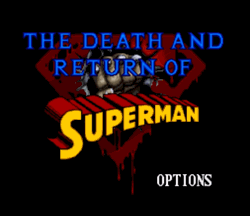 The Death and Return of Superman is a singular event in comics and videogames.
The Death and Return of Superman is a singular event in comics and videogames.
But not for the reasons you think…
First of all, let’s address the inevitable vocal nerd in the room. You might not comment, you might not say it out loud to anyone in particular, but I see you, comics nerd, because I am right there with you and your inevitably contrary opinions. In this case, my imagined strawman is spouting off the modern response to The Death and Return of Superman: “it doesn’t matter anymore, every comic book character dies”. And that’s true! In the current, modern age of comics (so defined as “any comic that came out after Iron Man: The Movie made Marvel a mint”) pretty much everyone has died and been revived in one manner or another. Spider-Man was mind-killed (but got better), every Green Lantern was killed and/or banished at one time or another (they’re all cool now), and even the Human Torch died and was revived in an event absolutely no one cared about. Death means nothing in modern comics, and even some of the “perennial” deaths have been overturned. Jean Grey is back as a teenager and a head-sock wearing adult, Bucky Barnes is an (apparently) immortal cyborg, and, despite the presence of like sixteen Wolverines across the X-franchise, it appears “regular” Wolverine is going to be back in action shortly. Death holds no sway over the comics page, and it’s a shock when Professor X actually stays dead for longer than ten minutes. Remember that time he got shot in the head, and it cured his paralysis? Good times.
So The Death and Return of Superman should have lost some of its luster after a thousand imitators. Heck, it wasn’t original in the first place, as it wasn’t even the first time Superman died. He used to die every other week back in the Silver Age of Comics! I know that sounds ridiculous, but, come on, if you found out your marriage to a gorilla (which only happened because you were cursed with a lion head) was legally binding, wouldn’t you rather conquer death before having to familiarize yourself with gorilla divorce law? Just leave your will etched into the moon, and you’re good to go hang out with mermaids again. 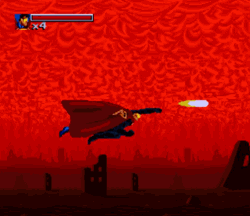 Point is that Superman was never going to stay in the grave, and, while there was a bit of buzz over “how does he die?” and “how does he come back?”, The Death and Return of Superman was never going to be all that original an idea right from its inception. It started as a writer’s room joke! The entire thing happened so they could sync a comics wedding with a television wedding! This whole event should have been more doomed than Superman!
Point is that Superman was never going to stay in the grave, and, while there was a bit of buzz over “how does he die?” and “how does he come back?”, The Death and Return of Superman was never going to be all that original an idea right from its inception. It started as a writer’s room joke! The entire thing happened so they could sync a comics wedding with a television wedding! This whole event should have been more doomed than Superman!
But… it wasn’t. Whether it was because of a surprisingly focused media campaign or just a bunch of nerds really interested in watching Superman bite the big one, The Death of and Return of Superman was a cultural event. Actually, it was probably that “Death” that was more read than the inevitable “Return”, but it’s likely at least 12% of that audience stuck around to figure out exactly why Clark Kent suddenly had a mullet. And, by comic book numbers, that’s an unprecedented success! Superman dying reinvigorated the whole of DC Comics, and paved the way for all sorts of amazing new story ideas and characters. Remember Kyle Rayner? Please say you do!
And, as an inevitable side-effect of being popular in the mid 90’s, The Death and Return of Superman got its own Super Nintendo/Sega Genesis game. This, taken on its own in 1994, should not have been a surprise. What is a surprise is that, in the intervening (nearly) 25 years, we haven’t seen a single other videogame based on one single comics arc.
That… is a bit absurd.
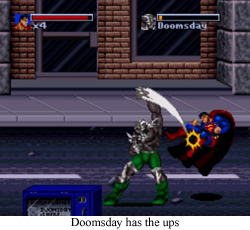 For those of you that don’t follow comic books, comic “arcs” are frequent, numerous, and often define a solid six months or so at a time. Because it’s difficult to write new and interesting plots every month, comic books often pursue arcs that are generally based on one hero battling one villain… but a lot of little problems get in the way for issue after issue. Often times, these arcs are transformed into “events”, and an event comic sucks every other comic it can find into its orbit. It’s not just about Batman fighting Joker, it’s about Joker infecting every other villain he can find, and, this month, The Flash has to battle Captain Cold, but he’s wearing clown makeup, so that’s new and interesting… right? These events are frequently just an excuse to goose the sales on good but publicly ignored titles (“This week, Yellow Lanterns fight The Blue Beetle! Next week: The New Gods!”), and, while we’re at it, maybe get some buzz from the fans thanks to some killer pull quotes like “things will never be the same again” or “Radioactive Man dies on every page”. Again, it’s all been watered down after years (decades) of repetition and hyperbole, but it appears to be the lifeblood of the superhero comics industry. Marvel Comics without sporadic events where everyone turns out to be a Nazi would hardly be Marvel Comics at all.
For those of you that don’t follow comic books, comic “arcs” are frequent, numerous, and often define a solid six months or so at a time. Because it’s difficult to write new and interesting plots every month, comic books often pursue arcs that are generally based on one hero battling one villain… but a lot of little problems get in the way for issue after issue. Often times, these arcs are transformed into “events”, and an event comic sucks every other comic it can find into its orbit. It’s not just about Batman fighting Joker, it’s about Joker infecting every other villain he can find, and, this month, The Flash has to battle Captain Cold, but he’s wearing clown makeup, so that’s new and interesting… right? These events are frequently just an excuse to goose the sales on good but publicly ignored titles (“This week, Yellow Lanterns fight The Blue Beetle! Next week: The New Gods!”), and, while we’re at it, maybe get some buzz from the fans thanks to some killer pull quotes like “things will never be the same again” or “Radioactive Man dies on every page”. Again, it’s all been watered down after years (decades) of repetition and hyperbole, but it appears to be the lifeblood of the superhero comics industry. Marvel Comics without sporadic events where everyone turns out to be a Nazi would hardly be Marvel Comics at all.
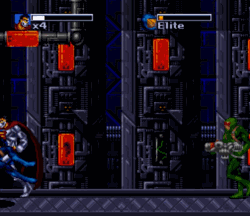 But, for every giant arc and epic event that has gone through DC and Marvel comics, barely any have made the leap to videogame land. What’s more, of the few arcs that made the transition to pixels (and weren’t just based on movies that came out a month prior), all of those stories were rewritten and repackaged as more generic adventures. It’s not “The Fantastic Four battle Galactus”, it’s “Marvel Superheroes”. It’s not “Spider-Man vs. The Green Goblin”, it’s just “Spider-Man”. And when he teams up with the X-Men… it’s not exactly because someone loved that time Arcade built his latest Murder World, it’s entirely because some company wanted to smoosh two super popular franchises together. There is a huge market for people that would absolutely kill for a Blackest Night or Sinestro Wars videogame… but the best we’re ever going to see is a generic Green Lantern game starring only Hal Jordan. And even that is probably only going to happen if there’s a new movie to promote.
But, for every giant arc and epic event that has gone through DC and Marvel comics, barely any have made the leap to videogame land. What’s more, of the few arcs that made the transition to pixels (and weren’t just based on movies that came out a month prior), all of those stories were rewritten and repackaged as more generic adventures. It’s not “The Fantastic Four battle Galactus”, it’s “Marvel Superheroes”. It’s not “Spider-Man vs. The Green Goblin”, it’s just “Spider-Man”. And when he teams up with the X-Men… it’s not exactly because someone loved that time Arcade built his latest Murder World, it’s entirely because some company wanted to smoosh two super popular franchises together. There is a huge market for people that would absolutely kill for a Blackest Night or Sinestro Wars videogame… but the best we’re ever going to see is a generic Green Lantern game starring only Hal Jordan. And even that is probably only going to happen if there’s a new movie to promote.
So what was different about The Death and Return of Superman? Why, of all the many, many comic book “epic stories” to come out over the last few decades, was this story of man vs. rock monster chosen to be exalted into beat ‘em up Valhalla with Mike Haggar and Michelangelo? Why is The Death and Return of Superman in my Super Nintendo, and not Generic Superman Adventure #327?
And, in playing The Death and Return of Superman, I think I have an answer: This is all about Superman, and that’s it.
The Death and Return of Superman technically features five playable characters: Steel, Cyborg Superman, The Eradicator, Superboy, and Superman: Original Flavor. Officially, that is five different people (mostly people), but, for the purpose of this beat ‘em up, they all play exactly the same. They all have a projectile, they all have a screen-clearing “super move”, and they all have a flurry of generic combos and attacks. And, in a way, that is fairly on-point gameplay, as there is supposed to be confusion as to who is the real Superman. Superboy is a clone, The Eradicator has the power, Cyborg Superman could have the body, and Steel has the heart and drive of the Man of Steel. They’re all supposed to be worthwhile Superman replacements, and, since they all play the same, they could all qualify. 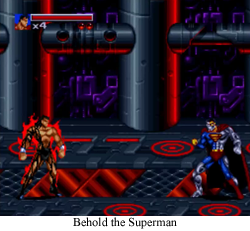 It’s not lazy coding, it’s a feature! And speaking of potential laziness, every boss (aside from Doomsday) is either an anonymous “trap” (like an angry robot), or another one of the Supermans. Cyborg Superman vs. Superboy. Eradicator vs. Steel. Superman vs. Cyborg Superman. This could practically be a fighting game for much of the plot, and it would be one featuring only variations on one character.
It’s not lazy coding, it’s a feature! And speaking of potential laziness, every boss (aside from Doomsday) is either an anonymous “trap” (like an angry robot), or another one of the Supermans. Cyborg Superman vs. Superboy. Eradicator vs. Steel. Superman vs. Cyborg Superman. This could practically be a fighting game for much of the plot, and it would be one featuring only variations on one character.
And that is the genius of it.
Remember those gigantic, epic “event” comics I mentioned earlier? Well, it’s not an exaggeration to claim that those stories often feature a cast of hundreds. And it’s easy to see how that happens, because when the average super team has an average of ten members, and everyone has to show up all at once, suddenly you’ve got a convention crowd battling the latest invader du jour. And that’s difficult to follow! Sure, you understand Superman or Batman’s deal, but what’s up with Elongated Man this week? Wasn’t he dead? Why does he look like a 20’s gangster? And is that supposed to be Martian Manhunter over there? Why the heck is he cosplaying as Blade? And this is all assuming this event isn’t occurring at some random point in another comic’s current “event”, so Wonder Woman isn’t inexplicably being played by her mom, or Batman isn’t a crazed Frenchman. In short, most comic book events require a primer just to know who’s who, and the industry has solved this problem by… releasing “the road to” comic events that explain the premise for the next event. Also, sometimes there is a denouement “aftermath” series that explains how everyone is reacting to the events of the last event. It generally previews the next event, too. What I’m trying to say is that reading comics requires a healthy amount of dedication, possibly bordering on constructing a bulletin board with a number of multicolored push pins.
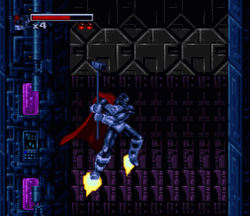 But The Death and Return of Superman doesn’t need any of that. Yes, the original series was grand and sweeping, and we certainly had at least one tie-in where we learned exactly how Aquaman felt about losing his land pal, but the core of the story, that which could be converted into a 16-bit title, is just a Superman story. It’s Evil Superman fighting Sidekick Supermans until Real Superman decides to make the scene. You don’t need Lois Lane. You don’t need Lex Luthor. And you certainly don’t need a guest appearance from Robin #4,187. No, all you need is a bunch of Supermans punching each other, and we’re good to go. The Death and Return of Superman is the ideal comic book event, because it can be converted into any format, and the audience doesn’t need to know anything more than the title. What is the Eradicator’s deal? Who cares! It’s time for super punches now!
But The Death and Return of Superman doesn’t need any of that. Yes, the original series was grand and sweeping, and we certainly had at least one tie-in where we learned exactly how Aquaman felt about losing his land pal, but the core of the story, that which could be converted into a 16-bit title, is just a Superman story. It’s Evil Superman fighting Sidekick Supermans until Real Superman decides to make the scene. You don’t need Lois Lane. You don’t need Lex Luthor. And you certainly don’t need a guest appearance from Robin #4,187. No, all you need is a bunch of Supermans punching each other, and we’re good to go. The Death and Return of Superman is the ideal comic book event, because it can be converted into any format, and the audience doesn’t need to know anything more than the title. What is the Eradicator’s deal? Who cares! It’s time for super punches now!
And that’s why The Death and Return of Superman is the only videogame distinctly based on one comic book event.
…
Well, except Maximum Carnage. But that one sucked.
FGC #387 The Death and Return of Superman
- System: Super Nintendo and Sega Genesis. The SNES version came out first, so I’m assuming the Genesis version is more of a port.
- Number of players: Despite the host of extra Supermans laying around, it’s only one player. A real shame there isn’t a playable Jimmy Olsen available.
- Friendly Fire: One interesting shift in the beat ‘em up standard here is that the random mooks can accidently fire missiles and punches at each other. Some really deft and careful dodging could probably lead to a successful “pacifist run” of everything but the bosses.
- Super Destructive: On the other hand, there’s something just plain satisfying about tossing a mutant into a background window, and earning a powerup for your troubles.
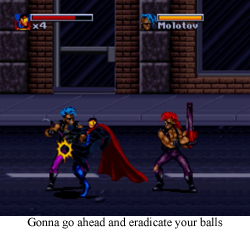 The Superman Problem: This is a beat ‘em up starring Superman, so, naturally, we have to deal with the whole “he’s not that super” problem. Doomsday is one thing, but OG Supes can lose health and lives to random punks with chainsaws! And so many random robots! Bah! Repeat to yourself it’s just a game, and you should really just relax.
The Superman Problem: This is a beat ‘em up starring Superman, so, naturally, we have to deal with the whole “he’s not that super” problem. Doomsday is one thing, but OG Supes can lose health and lives to random punks with chainsaws! And so many random robots! Bah! Repeat to yourself it’s just a game, and you should really just relax.- Favorite Superman: I’m going to say Steel for this game, as he’s the only Superman smart enough to show up with a weapon (a rad hammer, at that). Look, I know Superman has twelve billion powers, but kryptonite surfaces every other day, so maybe it would be a good idea to have a backup plan, Clark.
- Did you know? This game was developed by an early Blizzard Entertainment. Yes, that Blizzard. If you ignore Blackthorne (which almost everyone did anyway), this might be the first chronologically developed Blizzard game as Blizzard (as they were previously Silicon & Synapse). That’s just super.
- Would I play again: This is a beat ‘em up, and, while it’s interesting as a cultural artifact, it’s neither two players nor interesting enough to play again. Pass.
What’s next? Random ROB has chosen… Secret of Mana 2018! Or I just spent all weekend playing that game, and I really want to talk about it! Which I’m going to do! Please look forward to it!
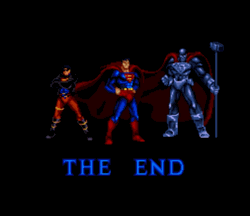
Beside the obvious “It’s About Superman”, I’m sure another pretty big reason why Superman’s death was treated seriously was because it happened before the Internet, and still well before the Internet became the huge resource of knowledge that it has. Back then, only comic superfans would’ve known that Superman used to die every other week. This was before we had the likes of Wikipedia and Superdickery to set us straight.
Back to “It’s About Superman”, not trying to drag a bazillion other comics into it definitely helped. The fallout from Civil War was felt all over the Marvel landscape in a “Why the fuck did you guys kill off all our characters and/or make them evil?!” way. I think the Iron Man comic wrote off Tony Stark’s asshole phase as demonic possession.
Oh well, least we got this great Squirrel Girl bit from the Civil War Snafu. https://www.cbr.com/meta-messages-squirrel-girl-tries-to-show-penance-the-error-of-his-ways/
[…] are almost entirely as outdated as a protractor? Continuity is king nowadays, and everything from Superman to the latest Kanye West album must contain no less than a decade’s worth of references and […]